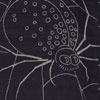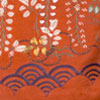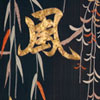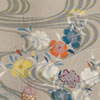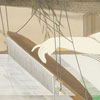Because beautiful garments were prized and carefully stored, even if they were rarely worn, many have survived and remain in excellent condition. Sometimes, the sponsor of a theatrical performance would reward an outstanding actor by tossing a sumptuous garment onto the stage. Military lords recognized loyalty in many ways, often with gifts of fine cloth and clothing. Finely woven fabrics also were valued, even if the original garments were worn; given to temples, they were cut up and reassembled into patchwork surplices to be worn by Buddhist abbots and high-ranking priests.
Eleven years ago, John Weber began collecting Japanese art by purchasing robes that resembled those he saw in ukiyo-e paintings of beautiful women. One group of garments on view in this gallery showcases the technical finesse and artistic genius of Japanese weavers, dyers, and embroiderers, in robes created for the wives of Japan's military elite and wealthy merchants in the eighteenth and nineteenth centuries. Traditional seasonal and floral motifs are intrinsic to their design.
Also on view are several garments from the first half of the twentieth century, classified as meisen, an immensely popular style during the Taishō period (1912-26), when artistic and technological exchange between Japan and the Western world escalated. In 1909, a silk-weaving center outside Tokyo developed an innovative stencil-printing process that modified the traditional labor-intensive technique of tying and dyeing bundles of thread by hand (called kasuri or ikat). This innovation, along with new bright chemical dyes, allowed artists to create complex, modern patterns that sometimes were influenced by contemporaneous international movements such as Art Nouveau and Art Deco. For young urban women of the middle and upper classes, these dynamic meisen kimonos reflected the worldly and adventurous spirit of an increasingly cosmopolitan Japan.



















